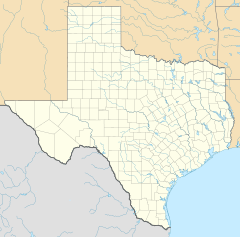Collegeport, Texas facts for kids
Quick facts for kids
Collegeport, Texas
|
|
|---|---|
| Country | United States |
| State | Texas |
| County | Matagorda |
| Founded | 1908 |
| Elevation | 10 ft (3 m) |
| Time zone | UTC-6 (Central (CST)) |
| • Summer (DST) | UTC-5 (CDT) |
| Zip code |
77428
|
| Area code(s) | 361 |
| FIPS code | 48-48321 |
| GNIS feature ID | 1379577 |
Collegeport is a small, unincorporated community in Matagorda County, Texas, United States. This means it's not an official city, but a group of homes and businesses.
It was founded on May 25, 1908. Collegeport is located right on Tres Palacios Bay, which connects to the larger Matagorda Bay. Even though its name includes "college," there isn't a college in Collegeport itself. However, the Texas State Technical College Marine Education Center is nearby, just across the bay in Palacios.
Contents
History of Collegeport
How Collegeport Started
Collegeport began in 1908 when a large piece of land, about 9,000 acres (around 36 square kilometers), was bought. Ranchers Jonathan Edward Pierce and Abel Brown Pierce sold their land to a developer named Burton D. Hurd. Mr. Hurd had a plan to build a new town. This town was supposed to have both a college and a port on Tres Palacios Bay.
Hurd advertised Collegeport as the "Town of Opportunity." He told people about the area's mild weather and good land for farming. Because of his advertising, many families started moving to Collegeport.
Growing into a Town
Just one year after the land was bought, Collegeport officially opened the Hotel Collegeport. It also had a Federated Church, which was special because it brought together 14 different religious groups.
By 1912, Collegeport had grown quite a bit. Its population was 496 people. There was a Business Men's League with 90 members and a Woman's Club with 86 members. The town also had an Episcopal Church. A new brick school house was being built. Collegeport was proud to have the first free public library in Matagorda County.
A professor named Will Travis opened the Gulf Coast University of Industrial Arts. He worked with orange growers to create a student labor program. A popular spot in Collegeport was its train station and a Pavilion built over the bay.
The town also had its own bank, Collegeport's State Bank. It was located on what is now Highway 1095. There were two local newspapers: the Collegeport Chronicle and the Collegeport New Era.
At its busiest, Collegeport had many businesses. These included three hotels, two hardware stores, a drugstore, and two grocery stores. There was also a barber shop, a planing mill, and shops for carpenters and blacksmiths. The town had doctors, a dentist, a veterinarian, and a lawyer. It also had a college, a high school, an ice house, and a pavilion with boat services. The Missouri Pacific Rail Station was also a key part of the town.
Challenges and Decline
Even though Mr. Hurd said Collegeport had a mild climate, the town faced problems with cold weather. In 1914, a very bad freeze hit the area. This freeze killed most of the crops that the farmers were growing.
After the freeze, there was a long period of dry weather, called a drought. Then, a disease spread that killed many farm animals. These problems caused many families to lose a lot. Because of these difficulties, a number of families decided to move away from Collegeport.
By 1935, the train depot was taken apart. It was then rebuilt as a building called the Mopac House. More trouble came in 1961 when Hurricane Carla hit the coast from the Gulf of Mexico. This powerful storm caused many of the original families who still lived there to leave Collegeport for good.
Collegeport Today
As of 2008, Collegeport is a quiet community. It has two churches, a community center, and the historic Mopac House. There is also a volunteer fire department and a post office.
Education
Children in Collegeport attend schools that are part of the Palacios Independent School District.
Climate
The weather in Collegeport is usually hot and humid in the summer. Winters are generally mild to cool. This type of weather is known as a humid subtropical climate.
See also
 In Spanish: Collegeport para niños
In Spanish: Collegeport para niños



